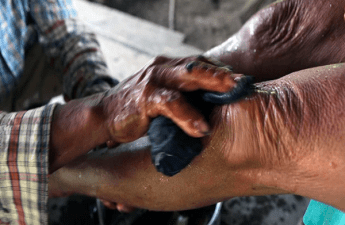Lady Gaga, who’s been on leave from her tour to contend with her fibromyalgia, surprised fans by showing up to a major fundraiser for hurricane relief this weekend. Gaga has recently been in the news not for her signature pop hits, but for her new Netflix documentary Five Foot Two, which shows the pain and struggles she experiences with this chronic illness. In doing so, Gaga has shed light on the very real struggle of living with an illness or disability that can be not only painful and difficult to manage, but also very hard to diagnose — and, frustratingly, tough for others to recognize.
The types of diagnoses that are sometimes described as “invisible illnesses” encompass a broad range of conditions — including Gaga’s diagnosis, fibromyalgia, which is a musculoskeletal disease — to migraines, endometriosis, and food intolerance. While some invisible illnesses are relatively easy for doctors to diagnose, others can go undiagnosed and untreated for years, causing not only intense physical but also emotional pain and stress. A common thread among patients who suffer from an invisible illness is that doctors will often have a tough time pinpointing what the condition is, and may even cast doubt on patients who come in with complex symptoms.
Jennifer Brea, a documentary filmmaker who has myalgic encephalomyelitis (ME), also known as Chronic Fatigue Syndrome, found this out the hard way. In a popular TED talk, Brea describes how the onset of debilitating pain and neurological abnormalities in her mid-20s led to several misdiagnoses from a variety of medical specialists — including neurologists, cardiologists, and psychiatrists — who all told her some version of “you’re physically fine.”
“All I had were my symptoms, which I could describe, but no-one else could see,” Brea remembers. The experience was isolating and made her feel tremendously powerless. In her TED talk about the very long and painful process of getting a diagnosis, Brea also explained that sexism frequently plays a role in the lack of treatment and research around invisible illnesses.
Case in point: Brea was told by a neurologist that she had conversion disorder, which some may know as a condition called hysteria — basically, an outdated diagnosis that has historically been used to dismiss psychological and physical conditions in (mostly) women. As Brea explains in her talk, when the medical field misdiagnoses patients with something like hysteria, the real underlying diseases get ignored, both in doctor’s offices when patients are desperate for help, but also in research. Marginalized by the medical community, many invisible illnesses do not receive adequate funding to find treatment or even causes.
Brea is now an activist for invisible illness awareness. Earlier this year she debuted a documentary, Unrest, about both her own diagnosis and the medical journeys of other people who have ME.
As Unrest shows, Brea is far from alone in dealing with not only the physical symptoms of her illness but the stigmas that come with having a disease that people can’t always see or understand. Alaina, who is 24 and lives in Boston, has been diagnosed with endometriosis, a painful condition where the tissue that lines the uterus grows outside the uterus, and Ehlers-Danlos syndrome (EDS), a set of disorders that affect connective tissues. Alaina tells Brit + Co that the EDS was diagnosed pretty quickly, but it took a long time to figure out she had endometriosis, leaving her totally bedridden for a few days each time she had a period.
Like Brea, Alaina also says she’s dealt with people who just refuse to believe her symptoms are real and legitimate. “I missed so many days my senior year of high school, for example, as a result of endometriosis, and people didn’t believe I could ‘actually’ be sick,’” she tells us. When it comes to her EDS, she says people take her “more seriously” when she uses her cane for support, but that people will also tell her she looks too young to use a cane, or that she can’t really be so sick she’d need to use one.
For others, the stigmas that come with invisible illnesses can put patients at the receiving end of character accusations or assumptions that have nothing at all to do with their disease. Diana-Ashley, who is 35 and lives in Maryland, has Crohn’s disease, which is an inflammation of the digestive tract that causes stomach pain, diarrhea, and fatigue, among other symptoms. She also suffers chronic migraines and, like Alaina, also has endometriosis.
Diana-Ashley tells us that in the past, co-workers have devised theories about why she was losing a lot of weight (Crohn’s causes significant weight loss), and why she needed so much medication. “There were accusations that I was abusing drugs, or that I was purposely starving myself,” she says. Because her colleagues couldn’t “see” that she was struggling with serious illnesses, they started rumors and offered unsolicited advice.
Invisible illnesses are complex in just about every way. They’re not always well understood by the medical community, come with a lot of misunderstandings and biases, and are sometimes wrapped up in a sexist history of not taking women’s pain seriously. Though as Brea states in her talk, she feels hopeful when she sees the resilience of ME patients, and finds strength in the community of others who share her diagnosis. If doctors and researchers can get on board with taking all invisible illnesses as seriously as patients do — and high-influence individuals like Lady Gaga continue to share their experiences — much more progress can be made.
What do you think about the treatment of invisible illnesses?



